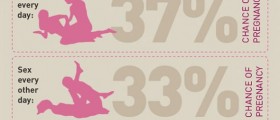Puberty is the period in the life of every woman when she changes from a child to a grown-up woman, a woman who is capable of reproduction and who is sexually mature. Puberty happens a little earlier in girls than in boys and manifests through many physical changes.
Girls are getting their periods, their breasts become bigger, and they get hair in several places on the body. All these changes happen because of estrogen, which is the main hormone in the female body.
In girls, puberty starts around the age of 9. At that age, they become taller, and they start gaining weight. The limbs are growing faster, and there can be seen more body fat, while the waist becomes narrower and the hips rounded and wider. The height and weight must be controlled by a doctor to grow properly.

Puberty Signs
One of the early signs of puberty in girls is the growth of breasts. It is very important to choose a training bra that is soft and comfortable. Apart from the breasts growth, many girls first notice hair on the places on their body, such as arms, legs, armpits, and pubic hair. The girls must consult their mothers or sisters if they want to shave their hair to do it properly.
At the age of 12 or 13, or happening earlier or later, each girl gets menstruation or menstrual flow which lasts at least 3 days. During this period, they must wear sanitary pads or tampons. The girls face various problems during this period, such as excessive menstrual flow, painful menstruation, and severe pains in the groin area. Fatigue, nausea, and vomiting can also appear while the period lasts.
Premenstrual syndrome (PMS) appears in girls a few days before they get menstruation. The premenstrual syndrome manifests itself through the girl’s mood. The girl becomes anxious, irritable, and sensitive, and she has sleeping problems. She is nervous without apparent and visible cause. Once the menstruation starts, the premenstrual symptoms disappear.
Do All Girls Go Through Puberty?
Some girls get through puberty earlier, and some later. The main thing is that each girl goes through it. It is also essential that, from that moment, she must take care of herself and her sexual life and have a doctor who would be familiar with all her problems and all this to grow up into a mature person capable of reproduction.
During this period, a girl must take care of her health, food and she must exercise.
- This study presents a scoping review of evidence relating to knowledge and experiences of puberty and menstruation among females aged 10–14 years in low- and middle-income countries.
- Forty-four items from 12 countries were identified from a systematic scoping review and screening of 8083 items. Included studies were quality assessed.
- A majority (40/44) of studies used school-based samples, and fifteen studies reported on interventions. Girls had inadequate knowledge about menstruation; menarche as a trigger for girls learning about menstruation was common. Adolescents struggled with menstrual hygiene. Negative emotions were associated with menarche and menstrual management. A minority of studies dealt explicitly with puberty. Most girls obtained information about menstruation and/or puberty from their mothers, although mothers were not necessarily girls’ preferred source for learning about these topics.

















Your thoughts on this
Loading...